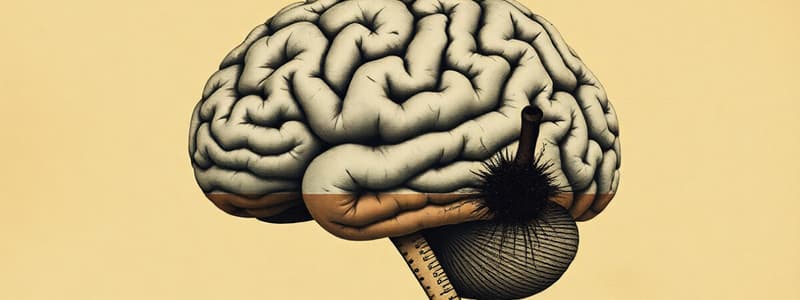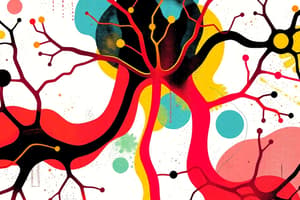Podcast
Questions and Answers
What main divisions comprise the nervous system?
What main divisions comprise the nervous system?
- Central Nervous System and Peripheral Nervous System (correct)
- Brain, Spinal Cord, and Peripheral Nervous System
- Somatic Nervous System and Autonomic Nervous System
- Brain and Spinal Cord only
Which part of the neuron is primarily responsible for transmitting signals?
Which part of the neuron is primarily responsible for transmitting signals?
- Cell body
- Axon (correct)
- Dendrites
- Synapse
What type of communication occurs when a neuron fires and transmits information?
What type of communication occurs when a neuron fires and transmits information?
- Chemical signals only
- Verbal signals
- Electrical signals only
- Action potentials and neurotransmitters (correct)
What cognitive function is primarily associated with the frontal lobe?
What cognitive function is primarily associated with the frontal lobe?
Which brain structure is crucial for memory formation?
Which brain structure is crucial for memory formation?
What is the role of the occipital lobe in the brain?
What is the role of the occipital lobe in the brain?
Which part of the neuron receives signals from other neurons?
Which part of the neuron receives signals from other neurons?
Which function is primarily linked to the amygdala?
Which function is primarily linked to the amygdala?
What does the principle of localization of function suggest about cognitive processes?
What does the principle of localization of function suggest about cognitive processes?
Which brain imaging technique offers high temporal resolution to track brain activity?
Which brain imaging technique offers high temporal resolution to track brain activity?
What role do feature detectors play in the brain's representation of information?
What role do feature detectors play in the brain's representation of information?
Which area of the brain is primarily involved in language comprehension?
Which area of the brain is primarily involved in language comprehension?
What distinguishes the 'What Pathway' from the 'Where Pathway' in visual processing?
What distinguishes the 'What Pathway' from the 'Where Pathway' in visual processing?
Experience-dependent plasticity refers to which of the following?
Experience-dependent plasticity refers to which of the following?
Which brain imaging technique involves tracking changes in blood flow?
Which brain imaging technique involves tracking changes in blood flow?
In regard to cognitive functions, how does distributed processing differ from localization?
In regard to cognitive functions, how does distributed processing differ from localization?
What kind of studies investigate cognitive impairments in patients with brain damage?
What kind of studies investigate cognitive impairments in patients with brain damage?
What is the primary function of single-cell recording in cognitive neuroscience?
What is the primary function of single-cell recording in cognitive neuroscience?
Flashcards
Cognitive Neuroscience
Cognitive Neuroscience
The study of how the brain connects to cognitive processes like thinking, learning, and memory. It combines psychology, neuroscience, and biology to understand how brain activity creates our thoughts.
Central Nervous System (CNS)
Central Nervous System (CNS)
The control center of your body, made up of the brain and spinal cord. It's responsible for processing information and sending commands to the rest of your body.
Peripheral Nervous System (PNS)
Peripheral Nervous System (PNS)
The network of nerves that extend throughout your body, connecting your CNS to your muscles, organs, and senses. It's like the communication lines between the control center and the rest of the body.
Neuron
Neuron
Signup and view all the flashcards
Action Potential
Action Potential
Signup and view all the flashcards
Synapse
Synapse
Signup and view all the flashcards
Cerebral Cortex
Cerebral Cortex
Signup and view all the flashcards
Hippocampus
Hippocampus
Signup and view all the flashcards
fMRI
fMRI
Signup and view all the flashcards
EEG
EEG
Signup and view all the flashcards
Localization of Function
Localization of Function
Signup and view all the flashcards
Distributed Processing
Distributed Processing
Signup and view all the flashcards
Neural Representation
Neural Representation
Signup and view all the flashcards
Feature Detectors
Feature Detectors
Signup and view all the flashcards
Population Coding
Population Coding
Signup and view all the flashcards
What Pathway (Ventral Stream)
What Pathway (Ventral Stream)
Signup and view all the flashcards
Where Pathway (Dorsal Stream)
Where Pathway (Dorsal Stream)
Signup and view all the flashcards
Experience-Dependent Plasticity
Experience-Dependent Plasticity
Signup and view all the flashcards
Study Notes
Cognitive Neuroscience Overview
- Cognitive neuroscience investigates the relationship between the brain and cognitive processes, merging cognitive psychology, neuroscience, and neurobiology.
- The nervous system has two main divisions: Central Nervous System (brain and spinal cord), and Peripheral Nervous System (nerves).
- Specialized brain structures support various cognitive functions.
Neural Building Blocks and Communication
- Neurons are the fundamental units of the nervous system, transmitting information electrically and chemically.
- A neuron's structure includes a soma (cell body), dendrites (receiving signals), an axon (transmitting signals), and a synapse (the gap for neurotransmitter release).
- Action potentials are electrical signals that travel along the axon, triggering neurotransmitter release at the synapse, enabling neuron communication.
Brain Structures and Functions
- The cerebral cortex (outer layer of the brain) supports higher-level cognition.
- The occipital lobe processes visual information.
- The temporal lobe plays a role in auditory processing, memory, and language.
- The parietal lobe processes sensory information and spatial awareness.
- The frontal lobe is associated with executive functions.
- The hippocampus is vital for memory formation and storage.
- The amygdala is linked to emotions, particularly fear and aggression.
- Specific areas like Broca's (language production) and Wernicke's (language comprehension) areas are crucial for distinct language functions.
Studying the Brain
- Brain imaging techniques (fMRI, EEG, PET) allow researchers to visualize brain activity during tasks.
- fMRI measures blood flow changes, enabling identification of active brain regions.
- EEG records electrical brain activity for high-temporal resolution.
- PET uses radioactive tracers to track brain activity.
- Single-cell recording measures activity from individual neurons.
- Lesion studies investigate cognitive effects from brain damage.
Brain Function: Localization and Distribution
- Localization of function suggests specific brain regions control specific processes (e.g., language areas).
- Neuropsychological evidence from brain-damaged individuals supports this concept.
- Distributed processing involves multiple brain areas cooperating for complex tasks like vision or memory.
Neural Representation and Perception/Action
- Neural representation describes how information is encoded in the brain.
- Specialized neurons called feature detectors respond to stimulus aspects (e.g., edges, movement).
- Population coding represents complex information with the coordinated activity of many neurons (e.g., face recognition).
- The brain uses separate pathways for visual processing: the ventral stream (what pathway) for object identification and the dorsal stream (where pathway) for object location and action.
Experience's Impact on the Brain
- Experience-dependent plasticity describes the brain's ability to adapt and change based on experience.
- Neural connections adjust based on learning, allowing for adaptation and skill acquisition.
Studying That Suits You
Use AI to generate personalized quizzes and flashcards to suit your learning preferences.




